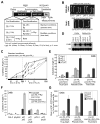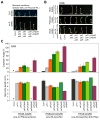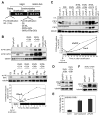Multiple phytochrome-interacting bHLH transcription factors repress premature seedling photomorphogenesis in darkness
- PMID: 19062289
- PMCID: PMC2651225
- DOI: 10.1016/j.cub.2008.10.058
Multiple phytochrome-interacting bHLH transcription factors repress premature seedling photomorphogenesis in darkness
Abstract
Background: An important contributing factor to the success of terrestrial flowering plants in colonizing the land was the evolution of a developmental strategy, termed skotomorphogenesis, whereby postgerminative seedlings emerging from buried seed grow vigorously upward in the subterranean darkness toward the soil surface.
Results: Here we provide genetic evidence that a central component of the mechanism underlying this strategy is the collective repression of premature photomorphogenic development in dark-grown seedlings by several members of the phytochrome (phy)-interacting factor (PIF) subfamily of bHLH transcription factors (PIF1, PIF3, PIF4, and PIF5). Conversely, evidence presented here and elsewhere collectively indicates that a significant component of the mechanism by which light initiates photomorphogenesis upon first exposure of dark-grown seedlings to irradiation involves reversal of this repression by rapid reduction in the abundance of these PIF proteins, through degradation induced by direct interaction of the photoactivated phy molecule with the transcription factors.
Conclusions: We conclude that bHLH transcription factors PIF1, PIF3, PIF4, and PIF5 act as constitutive repressors of photomorphogenesis in the dark, action that is rapidly abrogated upon light exposure by phy-induced proteolytic degradation of these PIFs, allowing the initiation of photomorphogenesis to occur.
Figures




Similar articles
-
Definition of early transcriptional circuitry involved in light-induced reversal of PIF-imposed repression of photomorphogenesis in young Arabidopsis seedlings.Plant Cell. 2009 Nov;21(11):3535-53. doi: 10.1105/tpc.109.070672. Epub 2009 Nov 17. Plant Cell. 2009. PMID: 19920208 Free PMC article.
-
Phytochrome signaling in green Arabidopsis seedlings: impact assessment of a mutually negative phyB-PIF feedback loop.Mol Plant. 2012 May;5(3):734-49. doi: 10.1093/mp/sss031. Epub 2012 Apr 5. Mol Plant. 2012. PMID: 22492120 Free PMC article.
-
Phytochrome-imposed oscillations in PIF3 protein abundance regulate hypocotyl growth under diurnal light/dark conditions in Arabidopsis.Plant J. 2012 Aug;71(3):390-401. doi: 10.1111/j.1365-313X.2012.04992.x. Epub 2012 Jun 11. Plant J. 2012. PMID: 22409654 Free PMC article.
-
Multiple kinases promote light-induced degradation of PIF1.Plant Signal Behav. 2011 Aug;6(8):1119-21. doi: 10.4161/psb.6.8.16049. Epub 2011 Aug 1. Plant Signal Behav. 2011. PMID: 21758014 Free PMC article. Review.
-
PIFs: systems integrators in plant development.Plant Cell. 2014 Jan;26(1):56-78. doi: 10.1105/tpc.113.120857. Epub 2014 Jan 30. Plant Cell. 2014. PMID: 24481072 Free PMC article. Review.
Cited by
-
Phytochrome regulates translation of mRNA in the cytosol.Proc Natl Acad Sci U S A. 2012 Jan 24;109(4):1335-40. doi: 10.1073/pnas.1109683109. Epub 2012 Jan 9. Proc Natl Acad Sci U S A. 2012. PMID: 22232680 Free PMC article.
-
Deletion of the RS domain of RRC1 impairs phytochrome B signaling in Arabidopsis.Plant Signal Behav. 2012 Aug;7(8):933-6. doi: 10.4161/psb.20854. Epub 2012 Jul 3. Plant Signal Behav. 2012. PMID: 22751357 Free PMC article.
-
Photoactivated phytochromes interact with HEMERA and promote its accumulation to establish photomorphogenesis in Arabidopsis.Genes Dev. 2012 Aug 15;26(16):1851-63. doi: 10.1101/gad.193219.112. Genes Dev. 2012. PMID: 22895253 Free PMC article.
-
SAUR17 and SAUR50 Differentially Regulate PP2C-D1 during Apical Hook Development and Cotyledon Opening in Arabidopsis.Plant Cell. 2020 Dec;32(12):3792-3811. doi: 10.1105/tpc.20.00283. Epub 2020 Oct 22. Plant Cell. 2020. PMID: 33093148 Free PMC article.
-
Interaction with plant transcription factors can mediate nuclear import of phytochrome B.Proc Natl Acad Sci U S A. 2012 Apr 10;109(15):5892-7. doi: 10.1073/pnas.1120764109. Epub 2012 Mar 26. Proc Natl Acad Sci U S A. 2012. PMID: 22451940 Free PMC article.
References
-
- Schafer E, Nagy F. Photomorphogenesis in Plants and Bacteria. Dordrecht, Netherlands: Springer; 2006.
-
- Nagatani A. Light-regulated nuclear localization of phytochromes. Curr Opin Plant Biol. 2004;7:708–711. - PubMed
-
- Jiao Y, Lau OS, Deng XW. Light-regulated transcriptional networks in higher plants. Nat Rev Genet. 2007;8:217–230. - PubMed
Publication types
MeSH terms
Substances
Grants and funding
LinkOut - more resources
Full Text Sources
Other Literature Sources
Molecular Biology Databases

